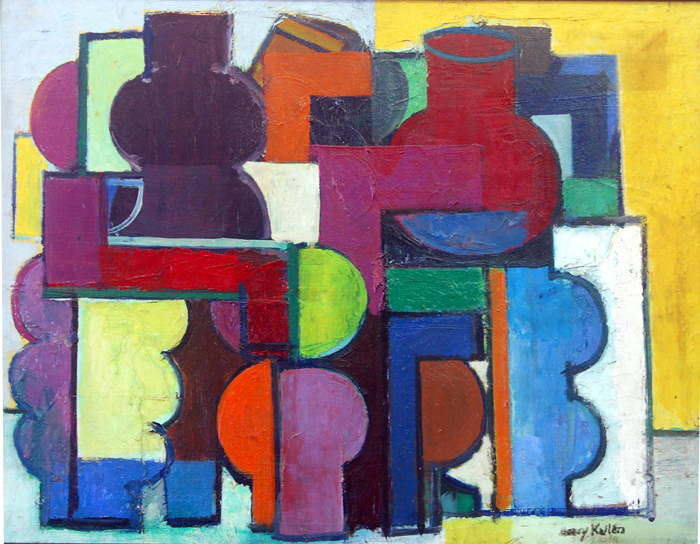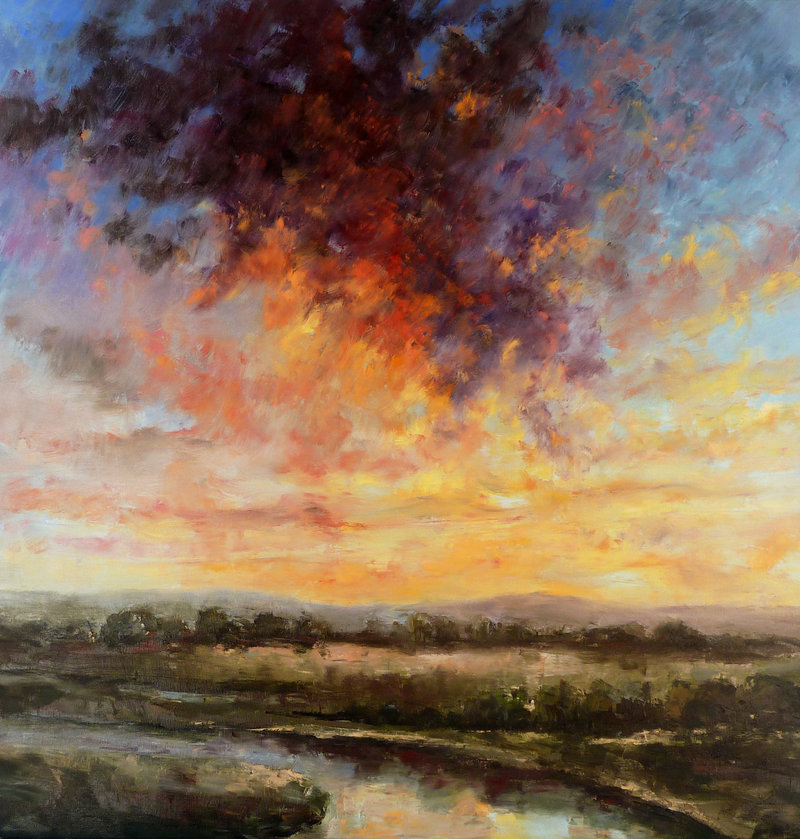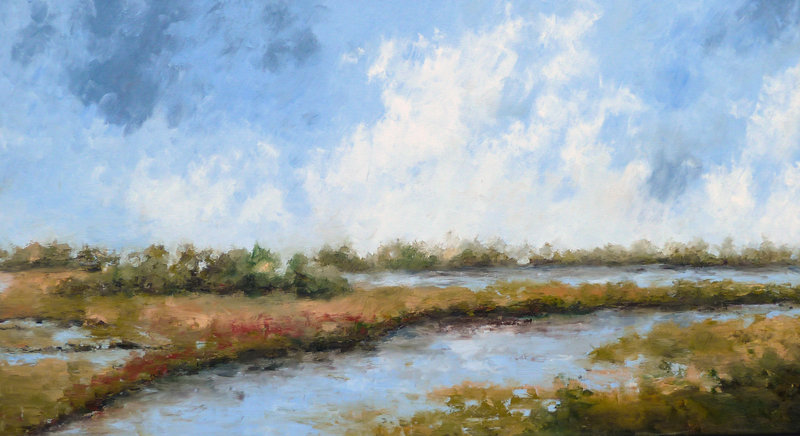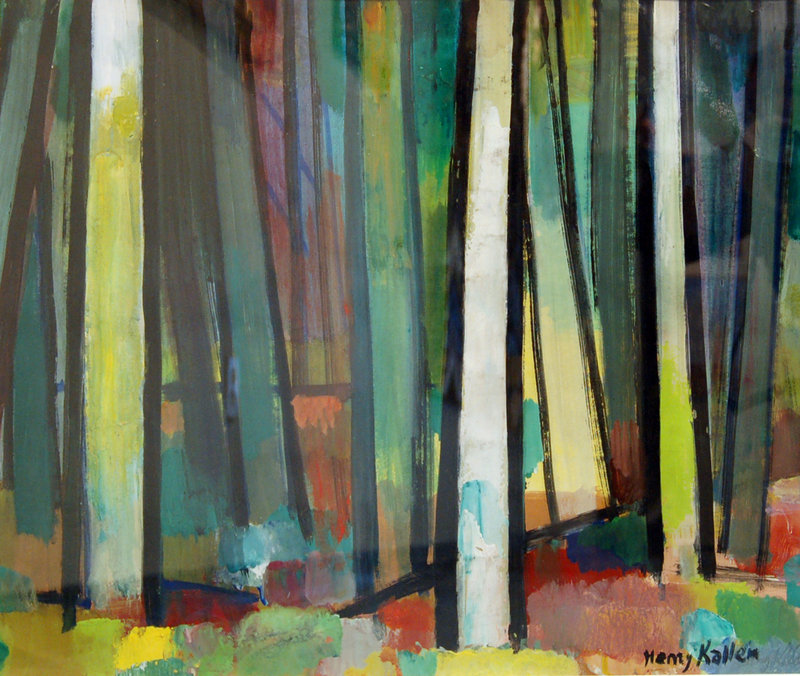Deborah Randall rather backed into painting Maine landscapes. She had been making content-oriented contemporary paintings with wildly varied subjects, but her ability to paint was strong, and a trip to Italy forced her not only to look at the landscape but see it in terms of painting.
After the trip, Randall continued working in both modes, and the landscapes became not only something she could do but a way of working that put the paint first rather than external ideas she would loan to herself now and again.
This transformation in approach is something that often marks the transition to being a mature artist. At first, it’s the struggle with the ideas that drives the artist to paint. Then the artist achieves a sort of fluency and begins thinking in the terms of the art so the ideas don’t require any sort of literal translation. In other words, the work becomes less about sense than sensibility.
“On the Horizon” at Elizabeth Moss Galleries in Falmouth features Randall’s moody landscapes with aggressive skies. She has made the rhythm and energy of her brushstroke into the most obvious and powerful component of her paintings.
This leads to many poignant effects, including a clear sense of urgency from her staccato strokes. Sometimes this can come across as hurried, but when it’s handled well, it exudes deftly excited energy. The quickness of the execution validates the viewers’ experience of the ephemeral unity of the painting: The image feels like a moment in a certain place rather than something broader, more complex or fractured.
“Sunset Over Little River” might be Randall at her best. The almost-square 4-foot canvas is about two-thirds sky over a bend in the river. The palette is 19th-century French with its sap greens, creamy yellows and rich, earthy reds. I particularly like its substantial cloud action. While it’s that familiar puff-dotted August sky that makes so many of us fall in love with Maine, Randall’s palette combines with her almost frantically muscular rhythms to make an unusually bold — even masculine — painting.
It might sound strange to talk about clouds of purple, red, brown and black, but the scheme works perfectly when backed with Naples yellow, soft pinks and light sky azures.
Randall’s knife work is strong, and she uses it particularly well in the foreground bands of landscape. She struggles, however, when shapes are allowed to take formal supremacy over the rhythms of the strokes.
In her “Marsh Light,” for example, an overly simple and somewhat awkward curve of brown marking the edge of the water is too unrelenting in palette and touch, and so unfortunately winds up dominating the composition. Fortunately, this tension between abstract forms and rhythmic structure is the exception rather than the rule in “On the Horizon.”
With the current ideas about branding, style and recognizability, we don’t spend enough time considering the range of modes of artists like Randall. Yet it’s rather standard fare for artists like Henry Kallem (1912-85), whose work occupies Moss’ center gallery.
Kallem was a noteworthy American modernist deeply tied to Monhegan and New York. Due to the time he worked, however, we aren’t surprised to see still lifes, landscapes, abstractions, interiors, portraits and so many other modes.
Such a range for a contemporary artist in a single show might strike many viewers as flighty or unfocused. Yet for the artists of Kallem’s era, the ability to shift gears was evidence of ability, awareness, worldliness and erudition.
While my favorite Kallem piece in the show is a forest of thick vertical-lined tree trunks that reminds me of Wilfredo Lam, I spent the most time parsing and comparing a pair of still lifes. One is light and airy, like a Monet vase of flowers painted by Chagall, what with its primary patches of background color and the joyously light touch in the vase that is rendered more than sufficiently with just a few outline strokes.
The other is a tight, heavy and flat cubist still life of bottles on a table. With echoes of Hoffman, Leger and Purism, it presents an impressive density despite appearing at first as dogmatically stylized.
Randall and Kallem are both intense, heady artists who ultimately love painting — and that shows in their rich surfaces and colors. If you like smart and energetic painting, there is much now to see at Elizabeth Moss.
Freelance writer Daniel Kany is an art historian who lives in Cumberland. He can be contacted at:
dankany@gmail.com
Send questions/comments to the editors.






Success. Please wait for the page to reload. If the page does not reload within 5 seconds, please refresh the page.
Enter your email and password to access comments.
Hi, to comment on stories you must . This profile is in addition to your subscription and website login.
Already have a commenting profile? .
Invalid username/password.
Please check your email to confirm and complete your registration.
Only subscribers are eligible to post comments. Please subscribe or login first for digital access. Here’s why.
Use the form below to reset your password. When you've submitted your account email, we will send an email with a reset code.